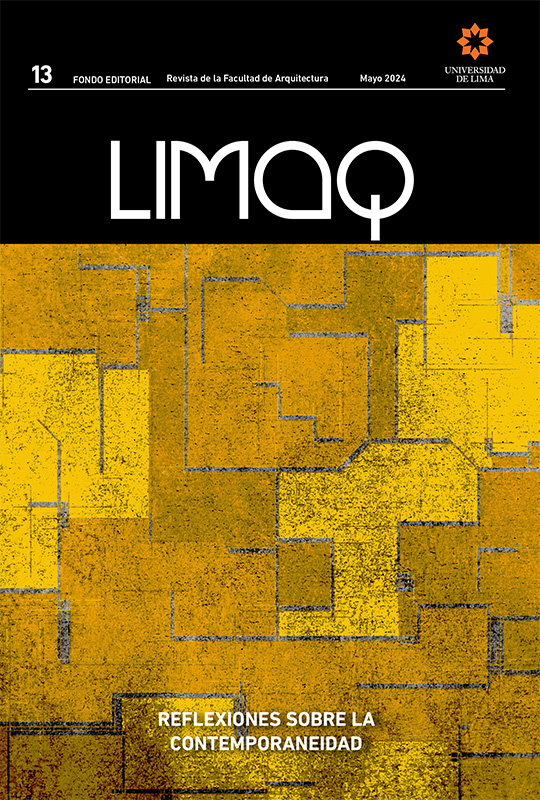The graphic movement of narrative time and the diverse design of content positioned by the authors
DOI:
https://doi.org/10.26439/limaq2024.n013.6504Keywords:
architecture, history, narrative, past, chronological timeAbstract
An extensive study of seven architecture history books published in the 20th century produced dozens of graphics and analyses regarding the movement of chronological time as a structuring element of the past. Although only a portion of these studies is presented in this article, the sample provided is sufficient to demonstrate the different ways in which each author constructs the positioning of dated events and the continuity of historical events. Each author interprets the facts according to a peculiar arrangement, even though that past may be conventionally represented in a seemingly impersonal narrative linguistic structure, and although hidden by the convention of written language, each author appears in their own narrative construction. This can be observed in the comparison of the different drawings present in the graphics and
analyses presented here, which allow us to verify how each historical narrative differs, and in fact almost never appears as a supposed linear and unambiguous interpretation of the facts.
Downloads
References
Agamben, G. (2009). O que é o contemporáneo? e outros ensaios (V. N. Honesko, Trad.). Argos.
Bonta, J. P. (1996). American Architects and Texts. MIT Press.
Cardoso, C. F., & Vainfas, R. (1997). Domínios da história. Ensaios de Teoria e Metodologia (5.a ed.). Campus.
Esteban-Maluenda, A., San Pablo, L. M., & Sánchez Carrasco, L. (2019). ArchiteXt Mining: Applying Text Analytics to Research on Modern Architecture. Život Umjetnosti, (105), 158-179.
Hobsbawm, E. J. (1995). O presente como história: escrever a história de seu próprio tempo. Novos Estudos CEBRAP, (43), 103-112.
Iggers, G. G. (1997). Historiography in Twentieth Century. Wesleyan University Press.
Lara, F. L. (2018). Excepcionalidade do modernismo brasileiro. Pensamento da América Latina (vol. 4). Nhamerica Platform, Romano Guerra.
Morin, E. (2011). Introdução ao pensamento complexo. Sulina.
Munslow, A. (2009). Desconstruindo a História. Vozes.
Novais, F. A., & Silva, R. F. (Eds.). (2011). Nova História em Perspectiva. Cosac Naify.
Ricoeur, P. (1997). Tempo e narrativa (t. III). Papirus.
Rocha-Peixoto, G. (2013). A estratégia da Aranha ou: da possibilidade de um ensino metahistórico da arquitetura (1.a ed.). Rio Books.
Tournikiotis, P. (1999). The Historiography of Modern Architecture. MIT Press.
Vázquez Ramos, F. G. (2015a, julio). Sobre a erudição (parte 1/4). Manfredo Tafuri e a historiografi a da arquitetura moderna. Arquitextos, 16(182.06). https://vitruvius.com.br/index.php/revistas/read/arquitextos/16.182/5621
Vázquez Ramos, F. G. (2015b, agosto). Sobre a erudição (parte 2/4). As primeiras histórias sobre a arquitetura moderna. Arquitextos, 16(183.06). https://vitruvius.com.br/index.php/revistas/read/arquitextos/16.183/5659
Vázquez Ramos, F. G. (2015c, setiembre). Sobre a erudição (parte 3/4). As histórias da arquitetura moderna, dos anos 1960-1970. Arquitextos, 16(184.07). https://vitruvius.com.br/index.php/revistas/read/arquitextos/16.184/5746
Vázquez Ramos, F. G. (2015d, octubre). Sobre a erudição (parte 4/4). As histórias sobre a arquitetura moderna sem erudição, 1980-2010. Arquitextos, 16(185). https://vitruvius.com.br/index.php/revistas/read/arquitextos/16.185/5770
Vidler, A. (2008). Histories of immediate present. Inventing architectural modernism. MIT Press.
Zein, R. V. (2011). Há que se ir às coisas. En G. Rocha-Peixoto, L. Bronstein, B. Santos & G. Lassance (Eds.), Leituras em Teoria da Arquitetura, Objetos (vol. 3, pp. 204-234). Rio Books.
Zein, R. V. (2020). O vazio signifi cativo do cânon. V!RUS, (20). http://www.nomads.usp.br/virus
Zein, R . V. (2022). Revisões historiográfi cas. Arquitetura moderna no Brasil. Rio Books.



